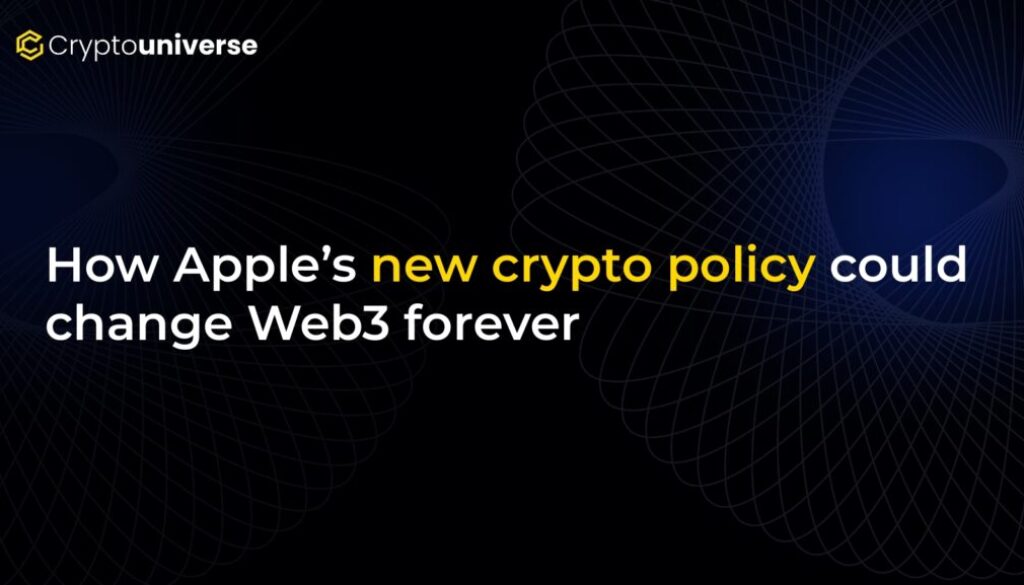How Apple’s new crypto policy could change Web3 forever

The digital world is holding its breath. In a move that sent shockwaves through the crypto community, Apple has begun to loosen its iron grip on the App Store, potentially altering the course of Web3 and the decentralized internet as we know it. For years, a fierce battle has raged between Apple’s walled garden and the open, permissionless ethos of Web3. Now, the walls are starting to crack.
This isn’t just a minor policy update; it’s a fundamental shift that could unlock billions of dollars in value and onboard millions of users into the world of crypto, NFTs, and decentralized applications. But as with any move from the tech giant, the devil is in the details. Is this a genuine step toward an open ecosystem, or a calculated move in a much larger game?
The “Apple Tax”: A Thorn in Web3’s Side
For years, developers have chafed under the infamous “Apple Tax”—the mandatory 30% commission Apple takes on all in-app digital purchases. While frustrating for any developer, this fee is especially crippling for the Web3 world, where transaction fees on blockchains like Ethereum or Solana are often between 2-5%.
This massive discrepancy created a hostile environment for crypto innovation on iOS. NFT marketplaces were reduced to simple “viewer” apps, unable to facilitate sales. Crypto wallets faced sudden removals and feature blocks for trying to enable simple token transfers. As one developer lamented after an app rejection, Apple’s stance was clear: no displaying NFTs unless they were purchased through Apple’s system, subject to the 30% cut.
The Fortress Cracks: Legal and Regulatory Pressure Mounts
Apple didn’t relax its rules out of goodwill. The change comes after years of intense legal and regulatory pressure from around the globe.
- The Epic Games Lawsuit: The high-profile case brought by the creator of Fortnite resulted in a landmark ruling. A U.S. federal court banned Apple’s “anti-steering” rules, which prevented developers from telling users they could find better prices on their websites. A judge later found Apple was deliberately ignoring the order, reinforcing that developers must be allowed to link to external payment options.
- The EU’s Digital Markets Act (DMA): Across the Atlantic, the European Union designated Apple a “gatekeeper,” forcing it to allow third-party app stores and alternative payment systems. Apple’s response—a complex new fee structure that critics called “malicious compliance”—showed its reluctance to give up control, with some developers pointing to a new 27% tax on web purchases as proof.
These legal battles forced Apple’s hand, leading to a crucial policy shift, particularly in the United States.
A Game-Changer for U.S. Crypto Apps
The biggest news from this saga is the change for U.S.-based developers. As of May 2025, Apple has officially relaxed its restrictions, allowing apps to include buttons and links that direct users to external websites to purchase digital goods like NFTs.
This is a massive breakthrough.
For the first time, an NFT marketplace app on an iPhone can let a user tap a button, go to the project’s website, mint an NFT, and see it in their in-app collection—all without Apple taking its 30% commission. The awkward workarounds and frustrating limitations are finally gone. The reaction on social media was immediate, with many hailing it as a huge moment for mobile crypto adoption.
🔴 BREAKING: The Apple Tax is dead 🔴
A federal court just ruled Apple must allow apps to link to external checkouts with no restrictions and no 30% cut.
Huge for crypto: apps can now sell NFTs, tokens, and digital assets directly and keep 100% of revenue.
However, outside the U.S., the situation remains complicated, with stricter global policies still in place, creating a fragmented experience for developers and users worldwide.
Apple’s Real Endgame: The “Appleverse”
On the surface, these policy changes look like a defensive reaction to legal pressure. But there’s growing evidence that Apple is playing offense, executing a long-term strategy to dominate the next era of the internet.
While CEO Tim Cook famously avoids the word “metaverse,” he speaks enthusiastically about Augmented Reality (AR). This points to a strategy focused on owning the interface where digital information blends with the physical world. The clearest proof is the Apple Vision Pro.
Apple doesn’t call it a headset; it’s a “spatial computer.” By creating the most advanced and polished hardware for this new immersive world, Apple is positioning itself to control the entire ecosystem from day one. Web3 projects are already lining up to build for the device, signaling an inevitable collision between these two worlds.
This is the classic Apple playbook:
- Watch a new technology emerge.
- Let others make the early, messy mistakes.
- Release a polished, user-friendly, and closed system that “just works.”
- Control the hardware, the software, and the marketplace.
- Set the rules and take a cut of everything.
By slowing down Web3’s progress on mobile with restrictive App Store rules, Apple is buying itself precious time to build its own version of the metaverse—an “Appleverse”—on its own terms.
The Final Showdown: Open vs. Closed
The coming years will define the future of our digital lives. On one side is Web3, a movement built on open protocols, user ownership, and decentralization. It’s chaotic, innovative, and permissionless. On the other is Apple, the master of the polished, top-down, and tightly controlled ecosystem.
The recent policy changes are a victory for Web3, but the war is far from over. With regulators chipping away at its fortress and developers refusing to back down, Apple is being forced to adapt. The question is whether the open internet can finally break into the walled garden for good, or if Apple will once again succeed in shaping a technological revolution in its own image.


